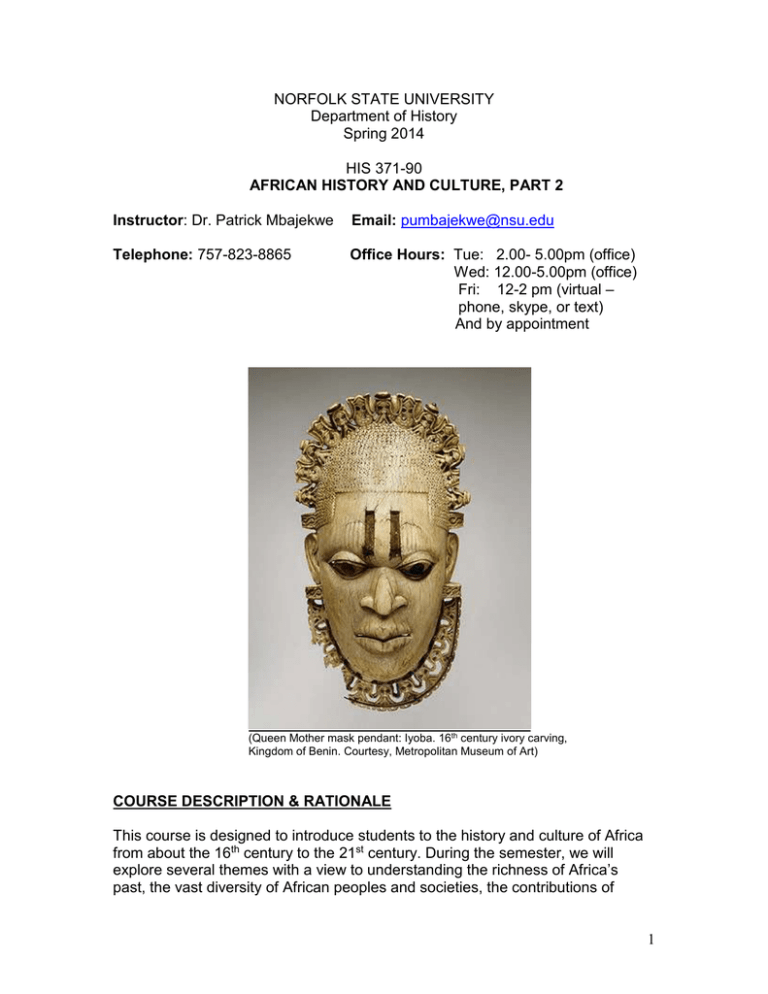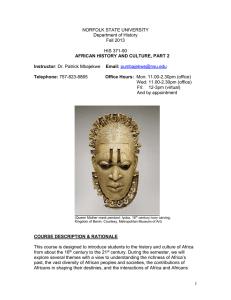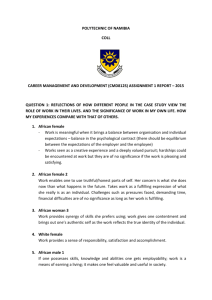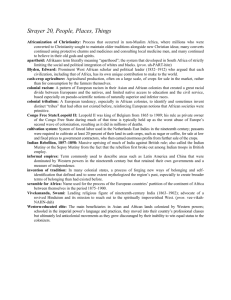
NORFOLK STATE UNIVERSITY
Department of History
Spring 2014
HIS 371-90
AFRICAN HISTORY AND CULTURE, PART 2
Instructor: Dr. Patrick Mbajekwe
Email: pumbajekwe@nsu.edu
Telephone: 757-823-8865
Office Hours: Tue: 2.00- 5.00pm (office)
Wed: 12.00-5.00pm (office)
Fri: 12-2 pm (virtual –
phone, skype, or text)
And by appointment
(Queen Mother mask pendant: Iyoba. 16th century ivory carving,
Kingdom of Benin. Courtesy, Metropolitan Museum of Art)
COURSE DESCRIPTION & RATIONALE
This course is designed to introduce students to the history and culture of Africa
from about the 16th century to the 21st century. During the semester, we will
explore several themes with a view to understanding the richness of Africa’s
past, the vast diversity of African peoples and societies, the contributions of
1
Africans in shaping their destinies, and the interactions of Africa and Africans
with the wider world. The course will take thematic, regional and chronological
approaches, and will use various strategies including readings, online
discussions, films, primary and secondary documents analyses, and other
strategies to expose students to variety of viewpoints on Africa’s past and
Africa’s relations with the world.
At the end of the course, students will gain general background knowledge of
African history, and deeper knowledge of some issues they might want to explore
further.
COURSE OBJECTIVES AND LEARNING OUTCOMES
This course is designed to expose students to the richness and diversity of
African cultures and historical experiences. In addition, the course reinforces and
emphasizes competencies in critical thinking and writing skills. It also offers skills
and content knowledge that will be useful in a variety of professions.
At the end of the course, students will be able to:
1. Trace the broad narratives of African history from circa 1600 to the
present
2. Distinguish between some of the myths, historical facts, and
interpretations about the people and continent of Africa
3. Trace and analyze some of the changes and continuities in Africa’s past
4. Analyze and interpret primary sources (including photographs) within their
historical context
5. Illustrate with appropriate examples, the roles of causation, process and
comparison in Africa’s past
6. Explore Africa’s interactions with the wider world, particularly with the
Middle East, Europe, and the Americas, and through that gain a deeper
appreciation of global interactions in historical perspectives.
COURSE REQUIREMENTS
1. Discussion Board Participation:
Since we do not have physical classroom meetings, your participation (which is
35% of your total course grade) will be determined by the frequency and
quality of your contributions in the Discussion Board.
You must participate actively in the discussions every week
Weekly discussion starts from Wednesday and ends on
Tuesday of the following week.
2
You must make your first posting by Saturday of that week, or
you will lose 40% of that week’s Discussion Board grade.
You must provide your original response (minimum 120
words) to the question(s) AND at least a response to TWO of
your peers’ postings. So I expect MINIMUM of THREE postings
from you each week. Of course, you can post more than that;
and I’m sure you will enjoy this course so much that you will
want to contribute more than three per week.
To maximize your grade, your original postings must be NO
LESS THAN 120 WORDS and must make substantial
contributions to the discussion, and be able to move the
conversation forward. Additionally, your peer responses must
add value to the discussion. Merely writing, “I agree with
John,” is NOT a contribution. You should tell us why you
agreed with John, and what more you have to add to what
John said.
You must show clear evidence that you read the assigned
materials, and then provide thoughtful comments. Your
comments could be in response to questions or issues I raised, or
those raised by other students, or you could raise additional
questions or issues.
Show sound reasoning in your contributions. You may cite personal
experience or research to help the class understand where you are
coming from
If you miss any week’s Discussion, you get a Zero for that
week. There will be no opportunity to re-open a Discussion
that has closed!
Because they add no value to the discussions, late entries are
NOT graded. You simply get a Zero for that week.
At the end of the semester all your Discussion participation grades
are tallied for the grand total of up to 35% of the course grade. (See
the Grading Rubrics)
Please, no profanity or vulgar language. No harassment or
intimidation. No advertisement of any kind.
However, we encourage differing viewpoints. Do not be afraid to
challenge. We can disagree while still respecting each other.
3
Use proper grammar, punctuations and spell check.
Stay on the topic
And ENJOY yourself. Showcase your knowledge of Africa. Ask
questions of other stuff you want to know about the continent and
the people. Engage and critique the reading materials, the
professor and other students. Previous students have told me that
the Discussion Board was the most enjoyable part of the course;
that they learnt so much about Africa by discussing the topics and
readings with their fellow students in the Discussion Board. I agree
with that assessment. One of the best ways to learn in an online
course is to be actively engaged in the Discussion Board.
2. Critical Thinking Exercises:
There will be TWO Critical Thinking Exercises in this course. You are
required to write four to six page essays each based on:
I.
Curtis Keim, Mistaking Africa: Curiosities and Inventions of the
American Mind (DUE ON
II.
Adam Hochschild, King Leopold’s Ghost (DUE ON )
The essays will be based on some specific themes or questions. I will post
additional instructions on the course Blackboard. ONE LETTER GRADE WILL
BE DEDUCTED FROM LATE PAPERS FOR EVERYDAY THEY ARE LATE. I
will therefore, advise you to start your assignments early.
3. Final Exam: We will have our final exam at the end of the term to reflect on
what we learnt in the course.
4. Grades: Evaluation will be as follows:
Critical Thinking Exercise 1
Critical Thinking Exercise 2
Final Exam
Weekly Discussion Board
20%
20%
25%
35%
Grade Distribution:
A
= 94-100
C+
= 77-79
A-
= 90-93
C
= 73-76
B+
= 87-89
C-
= 70-72
D-
= 60-62
F
= 0-59
4
B
= 83-86
D+
= 67-69
B-
= 80-82
D
= 63-66
Policy on Cheating and Plagiarism:
ZERO TOLERANCE FOR CHEATING: Scholastic dishonesty is a very serious
offense, and this instructor has zero tolerance for cheating. Standards of
academic conduct are set forth in the Norfolk State University Catalog. By
registering in this course, you have acknowledged your awareness of the
academic conduct policy, and you are obliged to become familiar with your rights
and responsibilities as defined by the policy. Violations of academic honesty,
which include but not limited to, plagiarism (presenting the words of others as
your own), cheating in examinations, or being complicit in such activities are
serious matters and will not be treated lightly.
Students with disabilities:
Students who need some type of disability accommodation in order to participate
fully in this class are advised to contact the Disability Services Coordinator, on
the Suite 110, Student Services Center, or at 757-823-8325 (bbharris@nsu.edu)
as soon as possible.
Assessment Statement:
As part of Norfolk State’s commitment to provide the environment and resources
needed for success, students may be required to participate in a number of
university-wide assessment activities. The activities may include tests, surveys,
focus groups and interviews, and portfolio reviews. The primary purpose of the
assessment activities is to determine the extent to which the university’s
programs and services maintain a high level of quality and meet the needs of
students. Students will not be identified in the analysis of results.
Possible amendments to the syllabus:
Your instructor, Dr. Mbajekwe, retains the right to change or to revise both the
general and supplemental syllabi at his discretion. Attend class in order to be
aware of any syllabi changes.
COMPUTER LITERACY REQUIREMENTS
This is an Online Course. To successfully complete this course, students
should:
Demonstrate at least an elementary knowledge of computers.
Understanding files and folders for the purpose of uploading or downloading
course content is essential.
5
o Basic computer literacy classes (CSC-150) are available.
Students lacking the necessary computer skills are strongly
encouraged to take such classes before enrolling in an
online class.
Demonstrate a good understanding of the use of Web resources such as
library and online research tools accessed through a Web browser.
Demonstrate familiarity with Microsoft Office applications such as Word
and PowerPoint. This is also essential.
Demonstrate a good understanding of how to operate NSU e-mail. This
will ensure effective communications between both instructor and classmates.
All students have been assigned an e-mail account and will be required to
access it regularly via the Web.
Blackboard LMS knowledge is essential for this course.
o For students not familiar with the Blackboard LMS, an online
orientation can be accessed by self registration in
Blackboard. The course name is “Blackboard Student
Training”. Further assistance with Blackboard can also be
obtained through the Blackboard Central Help Desk at
bbtechsupport@nsu.edu and by phone at 757-823-2328 M –
F 8AM – 5PM.
Please, submit all your works in Microsoft Word 2003 or higher. I may
not be able to open works submitted with any other program.
Required Texts (available in the university bookstore)
1. Erik Gilbert & Jonathan Reynolds, Africa in World History: From Prehistory to
the Present. 3rd edition. New Jersey: Pearson Prentice Hall, 2012
2. Curtis Keim, Mistaking Africa: Curiosities and Inventions of the American Mind.
3rd edition. Boulder, CO: Westview Press, 2013
3. Adam Hochschild, King Leopold’s Ghost: A Story of Greed, Terror, and
Heroism in Colonial Africa. Boston & New York: Mariner Books, 1999
Additional Materials available in the Course Blackboard:
Chimamda Adichie, “The Danger of a Single Story.” TED Lecture Series, 2009
http://www.ted.com/talks/lang/eng/chimamanda_adichie_the_danger_of_a_single
_story.html
6
Funso Afolayan, “Kingdoms of West Africa: Benin, Oyo and Asante,” in Toyin
Falola ed. Africa. Vol 1: African History Before 1885, pp. 161-189
Patterson, T. R. and Robin D.G. Kelley. “Unfinished Migration: Reflections on the
African Diaspora and the Making of the Modern World.” African Studies Review
43, (April 2000): 11-45
Andrea Cornwall, “Introduction: Perspectives on Gender in Africa.” In Readings in
Gender in Africa ed. Andrea Cornwall. Indiana University Press, 2005, 1-19
Magubane, Zine. “The Influence of African American Cultural Practices on South
Africa, 1890-1990.” In Leisure in Urban Africa, ed. Paul T. Zeleza and Cassandra
Veney. New Jersey: Africa World Press, 2003.
Schedule
Part I: Africa: Myths and Realities
Unit One, January 11-21:
A.
Introduction to the course
1. Read the course syllabus, pay attention to the course requirements
2. Familiarize yourself with the Blackboard. If you have trouble, please
contact the Blackboard Helpdesk at 757-823-8678
3. Introduce yourself to the class. Post introduction to the Discussion
Board: your name, major, year in the college, profession, interests,
hobbies, and why you are taking this course.
4. Start reading Curtis Keim, Mistaking Africa
B. Africa: Myths and Realities
Readings: 1. Curtis Keim, Mistaking Africa: Curiosities and Inventions of
the American Mind, 2nd edition. Preface, Chapters 1, 2, 3, 4, & 5.
Themes:
1. Explore some of the various myths, images, (mis) representations,
ideas, and stereotypes about Africa
2. How did those images and representations become the basis of
knowledge that students sometimes bring with them to their study of
Africa
3. Begin to separate the myths from the realities
7
Unit Two, Jan. 22-28:
Africa: Myths and Realities, continues
Reading: Curtis Keim, Mistaking Africa: Curiosities and Inventions of the
American Mind, 2nd edition Chapters 6 – End
Video: Chimamda Adichie, “The Danger of a Single Story.” TED Lecture
Series, 2009
http://www.ted.com/talks/lang/eng/chimamanda_adichie_the_danger_of_a
_single_story.html
Themes:
1.
2.
3.
4.
Explore the myth of the “Dark Continent.”
Explore the diversity of the African continent
Explore the myth of “Broken Africa” – Africa of the “charity case.”
Why do certain images of Africa and Africans predominate, and why
are certain other images far less common in popular western media?
5. New directions: from imagination to dialogue
Critical Thinking Exercise #1 Due: January 29
Part II: Eastern and Western Africa, 1600-1900
Unit Three: Jan. 29-Feb. 4:
Eastern Africa & the Swahili City-States
Reading: Erik Gilbert and Jonathan Reynolds, Africa in World History,
Chapters 8 & 12
Themes:
1.
2.
3.
4.
5.
East Africa and the Indian Ocean commercial network
The origins of the Swahili
The Portuguese in East Africa
The Arab-Omani rule in East Africa
East Africa in Global Perspectives
8
Unit Four, Feb. 5-11:
The Yoruba Kingdom of Oyo, the Edo Kingdom of Benin, and the
Akan Kingdom of Asante
Reading: Funso Afolayan, “Kingdoms of West Africa: Benin, Oyo and
Asante,” in Toyin Falola ed. Africa. Vol 1: African History Before 1885, pp.
161-189
Themes:
1.
2.
3.
4.
5.
6.
7.
The Yoruba people of south-west Nigeria, and rise of Oyo empire
The Edo (Bini) and the rise of the Benin kingdom
The Akan people of Ghana and the Kingdom of Asante
State-building in pre-colonial West Africa
The political structures of the states
Contact with Europeans
The decline and fall of the states
Part III: Africa and the Atlantic Slave Trade
Unit Five, Feb. 12-18:
The Atlantic Slave Trade
Reading: Gilbert & Reynolds, Chapter 9
Themes:
1.
The origins of the trade
2.
The New World and the birth of the Plantation Complex
3.
Why Africans?
4.
The organization and institutions of the trade in Africa and the
Americas.
5.
The Middle Passage
6.
Resistance and revolts
7.
Impacts of the trade on Africa, Europe and the Americas
8.
On the meaning and history of slavery
9
Unit Six, Feb. 19-25:
Africa and the African Diaspora
Reading: Patterson, T. R. and Robin D.G. Kelley. “Unfinished Migration:
Reflections on the African Diaspora and the Making of the Modern World.”
African Studies Review 43, (April 2000): 11-45
Themes:
1. The Origins of the Diaspora
2. Review of the historiography of the African Diaspora
Part IV: Southern Africa, 1500-1870
Unit Seven, Feb. 26-Mar 4:
Southern Africa
Reading: Gilbert & Reynolds, Chapter 13
Themes:
1.
2.
3.
4.
5.
6.
Early southern African societies
The Dutch (European) settlement
Shaka and the rise of the Zulu state
The Mineral Revolution in South Africa
The British-South African War
The origins of apartheid
Part V: European Colonial Conquest of Africa
Unit Eight, Mar. 5-11:
European Imperial Conquest & African Resistance: The Scramble for
and Partition of Africa
Reading: Gilbert & Reynolds, Chapter 14 & Adam Hochschild, King
Leopold’s Ghost
Themes:
1.
2.
3.
4.
Reasons for imperialism
Patterns of European conquest of Africa
The tools of conquest
African resistance
10
SPRING BREAK: Mar. 11-16
Unit Nine: Mar 17-25:
European Colonial Conquest of Africa: Leopold & the
Congo Case Study
Reading: Adam Hochschild, King Leopold’s Ghost
Critical Thinking Exercise # 2 Due: March 26
Part VI: Africa and Colonial Rule
Unit Ten: Mar 26 – Apr. 1
A: The Colonial Economy
Reading: Gilbert & Reynolds, chapter 15
Themes:
1.
2.
3.
4.
5.
Fundamental principles of the colonial economy
Cash crop production
Mining
Colonial economic balance sheet
Gender and Class in Colonial Africa
Unit Eleven: Apr 2-8
B: Colonialism and Social Change
Reading: Gilbert & Reynolds, chapter 17
Themes:
1.
2.
3.
4.
Colonialism and social transformation
Christianity and Africa
Western education
Urbanization and popular culture
11
PART VI: POST-COLONIAL AFRICA
Unit Twelve: Apr 9-15
Decolonization and Independence
Reading: Gilbert & Reynolds, Chapter 18
Themes:
1.
2.
3.
4.
5.
The Rise of African nationalism
World War II and the acceleration of nationalist movements in Africa
Pan-Africanism
The Prospects and Challenges of Independence
Independent Africa in the era of globalization
Unit Thirteen: Apr. 16-22
Mandela, Apartheid and South Africa
Reading: 1. John Iliffe, “Industrialization and Race in South Africa, 18861994,” in Iliffe, Africans: The History of a Continent. Cambridge University
Press, 2007, 273-287
2. Gilbert & Reynolds, pp. 390-391
Themes:
1. Mining and industrialization in South Africa
2. Racial segregation and white domination
3. The end of apartheid
4. The legacies of Nelson Mandela
Unit Fourteen: Apr. 23-May 2:
Contemporary Africa in Global Perspectives
Readings: Gilbert & Reynolds, Chapter 19
Themes:
1. The end of Cold War and political changes in Africa
2. Post-colonial political conflicts
3. Africa and the United States
4. Africa and China
5. Africa’s Renaissance
6. Looking Ahead
12
Final Exam: May 4
GRADING RUBRICS
Discussion Board Participation Rubric
Grade
Grading Criteria
A: 90-100
B: 80-89
C: 70-79
D: 60-69
Responses are on topic, original, and contribute to the
quality of the discussion
Responses make frequent, informed references to the
REQUIRED reading materials
Responses are written clearly, and are of reasonable
length
One or more additional responses to classmate(s) that are
thoughtful and advance the discussion
Responses are on topic, largely original, and contribute to
the quality of the discussion
Responses make some informed references to the
REQUIRED reading materials
Responses are generally clearly written, and are of
reasonable length
Response(s) to classmate is somewhat thoughtful
Responses are on topic, but lack originality, and lack a
significant contribution to the quality of the discussion
Responses make vague or summary references to the
REQUIRED reading materials
Responses have several stylistic or mechanical errors
Response(s) to others does not advance the discussion
Responses are only partially on topic, lack originality, and
lack a significant contribution to the quality of the
discussion
Responses make little or no references to the REQUIRED
reading materials
Responses have several mechanical or stylistic errors
No responses to classmates
If there are more than one question, student did not
respond to all of them
13
F: 0-59
Responses are off topic, lack originality, and lack any
contribution to the quality of the discussion
Responses make little or no reference to the REQUIRED
reading material
Responses have several mechanical or stylistic errors
Response is abusive or inappropriate (will result in 0 point
automatically)
Response is PLAGIARIZED (will result in 0 point
automatically)
No responses at all (0 point)
No responses to classmates
Grading Rubric for the Critical Thinking Exercises
A:
90 100
pts
B:
80 89
pts
C
70 –
79
CONTENT
ORGANIZATION
WRITING STYLE
MECHANICS
Includes a strong introduction
and conclusion. Shows
original thought. Supports
arguments well (no logical
flaws; sources used to support
arguments). Develops main
points clearly. Includes
appropriate citations where
necessary. Meets assignment
length requirement.
Information flows
logically from one idea to
the next with clear and
smooth transitions
Transitions found
between and within
sections must be clear
and effective.
Appropriate to the
assignment, fresh
(interesting to read),
accurate (no farfetched,
unsupported
comments), precise
(say what you
mean), and concise
(not wordy).
Project is free of serious
errors. Ideas are clearly
expressed; only a one or
two minor spelling,
punctuation, and/or
sentence structure errors
that do not interfere with
the readability of the paper
Includes a good introduction
and conclusion but that need
some revision. Shows original
thought. Supports most
arguments concretely (no
logical flaws; sources used to
support most claims).
Develops the main points
clearly. Includes appropriate
citations where necessary.
Meets assignment length
requirement for the most part.
Information flows with
relative coherence from
one idea to the next.
Each section has good
internal
organization. Transitions
found between and
within sections are
mostly clear and
effective.
Should generally be
appropriate to the
assignment,
accurate (no farfetched,
unsupported
comments), precise
(say what you
mean), and concise
(not wordy).
Contains some generally
minor grammatical and
punctuation errors. Few
misspellings. minor
punctuation, and/or
sentence structure errors
that do not significantly
interfere with the readability
of the submission
The introduction and/or
conclusion do not set up or
close the paper very
effectively. The paper is
The organization has a
few problems. Sections
lack transitions, and
several sentences may
Appropriate in
places, but
elsewhere language
is vague and/or
Numerous grammatical
and punctuation
errors. Misspellings are
more frequent, but they are
14
pts
largely informative with little
persuasive claim. Some
arguments and ideas are
supported with appropriate
references, but others may not
be. Failed to meet
assignment length
requirement
be monotonous or
confusing. The overall
structure of the
assignment is not
effective. Need to use
paragraphs to organize
your essay.
inappropriate.
the sort spell checkers do
not catch, such as
"effect/affect." Connections
generally made from one
idea to the next; unclear
transitions
D
The introduction or conclusion
is poorly developed, or nonexistent. The essay's main
points are developed
inconsistently, or repetitiously
and none, or almost no,
connection made from one
idea to the next. Relies too
heavily on personal
experience. Addresses many
topics but at a surface level,
no in-depth thought. The
paper is largely informative
with little persuasive claim.
Does not include references.
Far less than the required
assignment length.
The paper’s organization
has multiple
problems. Most sections
lack transitions, and
sentences are often
monotonous or
incomprehensible. The
overall structure of the
assignment is not
effective.
Inappropriate and
vague writing
interferes with the
development and
clarity of the main
points.
Many serious and minor
grammar or punctuation
errors; frequent
misspellings, including
those that should have
been caught by the spellchecker.
60 69
pts
F
0–
59
pts
Inappropriate topic or topics unrelated to requirements
Plagiarized work: (Lifting the work of others – from the internet or other sources – and passing it as your own.
Results in outright Zero. See Policy on Plagiarism)
No Paper Submitted
15








